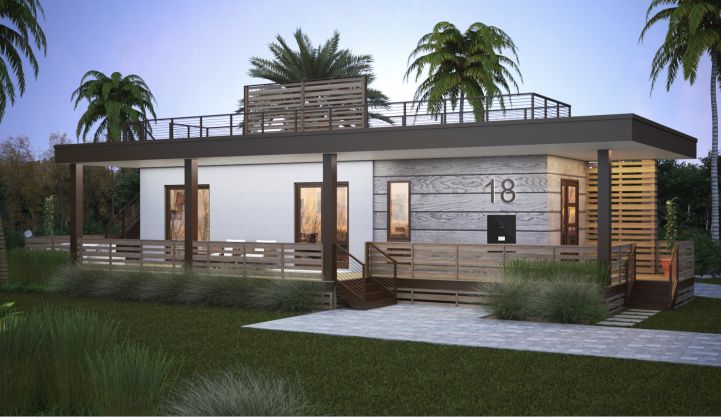A Florida homebuilder partnered with sonnen to build “climate positive” homes equipped with solar and battery storage.
Pearl Homes expects to complete 148 homes next year at Hunters Point, in the coastal town of Cortez, Florida, south of Tampa. The buildings, pursuing LEED Platinum certification, are designed not only to supply as much energy as they consume, but also to have a net positive impact on the overall energy system.
A planned second phase would expand the design to 720 rental units, making the high-tech clean energy lifestyle available to people who aren’t in the market to buy.
“We’re going to reduce carbon dioxide emissions to the absolute minimum,” said sonnen Senior Vice President Blake Richetta. “Forget ‘produce as much as you consume’ — we need to offset carbon dioxide emissions as much as we put them into the environment.”
The homes could pursue this mission by charging their batteries when power is cheap and lower-carbon, and discharging to the grid when peak demand pushes up the carbon intensity of generation.
In its home country of Germany, which has a much more active residential storage market, sonnen operates a network of 30,000 home battery systems, which it aggregates for grid participation. It offers customers free electricity if they participate in the distributed power plant model.
That system hasn’t been possible in the U.S., due to regulatory and market design barriers. Instead, sonnen has looked to homebuilders as a strategy for large-scale deployment.
First came Mandalay, which signed up for 2,900 homes with sonnen batteries in Arizona, utilizing a special rate structure from utility Arizona Public Service that incentivizes reducing grid demand during the evening peak hours.
Like Mandalay, Pearl Homes is pushing ahead with its plans before finalizing a grid services contract with its utility, in this case Florida Power and Light. The strategy is to build the assets, and then see what it can do with the 7.2 megawatts and 9 megawatt-hours of capacity across the Hunters Point development.
That means the homes have to attract customers on their own. To this end, Pearl has crafted highly energy-efficient designs equipped with Google Home automation. Besides controlling electricity consumption throughout the day, the sonnen batteries will offer resilient backup power in the face of outages, especially appealing in a hurricane-prone region.
The battery product itself marks a new development for sonnen, Richetta said.
The U.S. branch launched the more expensive ecoLinx model in September aimed at high-end home automation customers. The systems going into Hunters Point will be lower-priced and connected with the more ubiquitous Google Home automation system — like ecoLinx for the broader market, Richetta said.
The target audience for this project is “eco-progressive, younger, excited about new technology — not affluent but not cash-strapped,” Richetta said.
The connected systems should enable the battery to lower the shades and precool the home when solar generation is cranking midday, and then gently turn down AC and lights to load-shed during peak hours without affecting comfort.
The model home is built, and construction on the development is planned to start in June 2019 and last for six months. The larger second phase would be completed nearby by 2022.
That second project, assuming it unfolds as planned, would be the first major development to give renters access to solar-plus-storage, normally the province of homeowners.
“We’re trying to innovate the market opportunity here,” Richetta said. “The market is broadened because the renter doesn’t buy the energy storage system; it’s an asset of the developer.”
It’s hard to get customers to drop thousands of dollars for a battery that may take many years to pay for itself, although a growing number of Americans are making that purchase. Partnering with homebuilders lets storage companies slide their capital expense into the mortgage. In a rental building, the developer pays for the batteries, and then gets to use them.
The company can claim tax and depreciation benefits from using the storage as a capital asset, Richetta noted.
More significantly, if Pearl Homes can hammer out a grid services contract with utility Florida Power and Light, it will be the only counterparty. That reduces complexity compared to a model that aggregates the property of individual homeowners. Similarly, solar installer Sunrun has pushed toward grid services with its fleet of solar-plus-storage systems that it owns and leases to customers.
Aggregators have to balance reliable delivery of grid services with the interests of the customers who actually paid for the equipment in their homes. The industry is still very early on in the process of figuring out the right way to do that. Centralized ownership of rented units, with customers getting clean power and backup along the way, could play a bigger role in that conversation.




